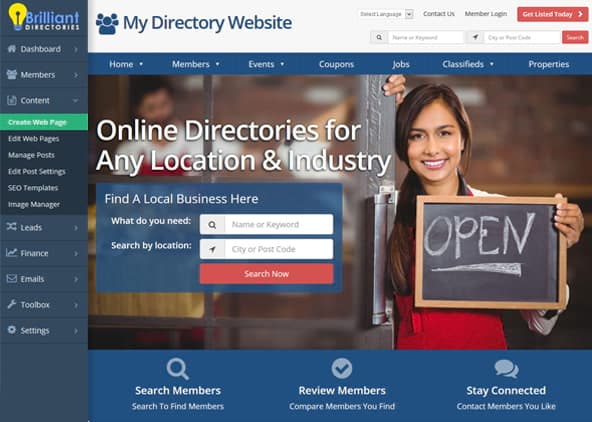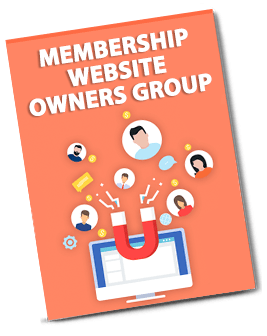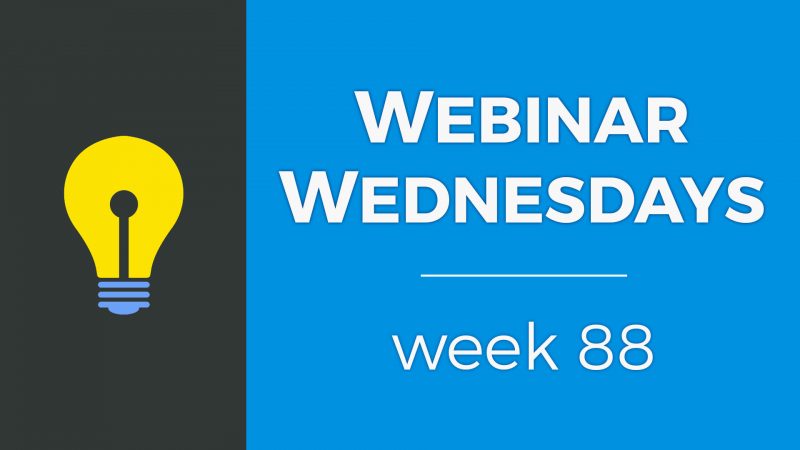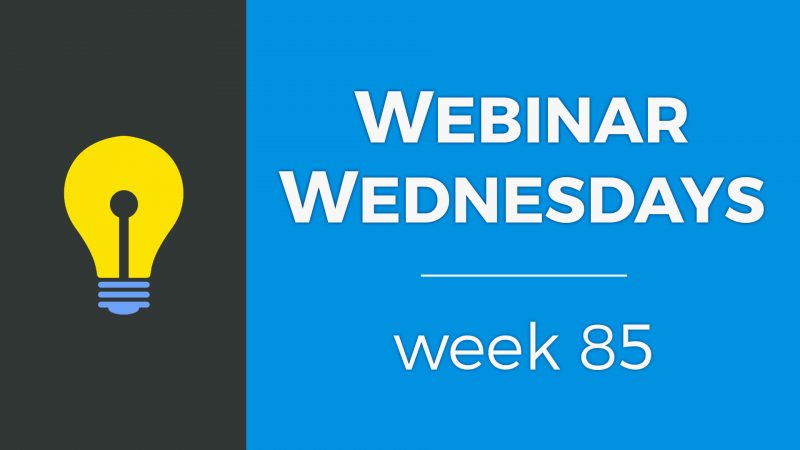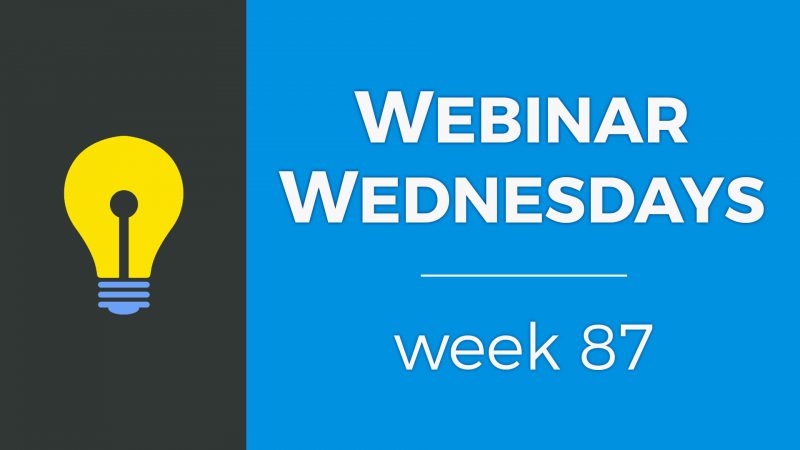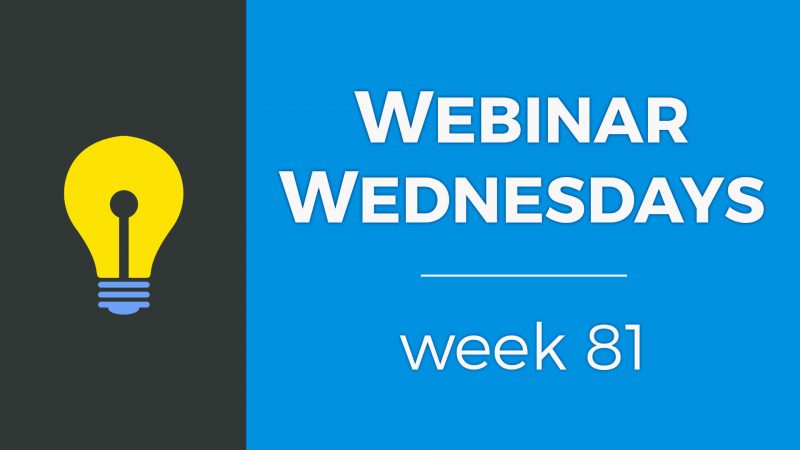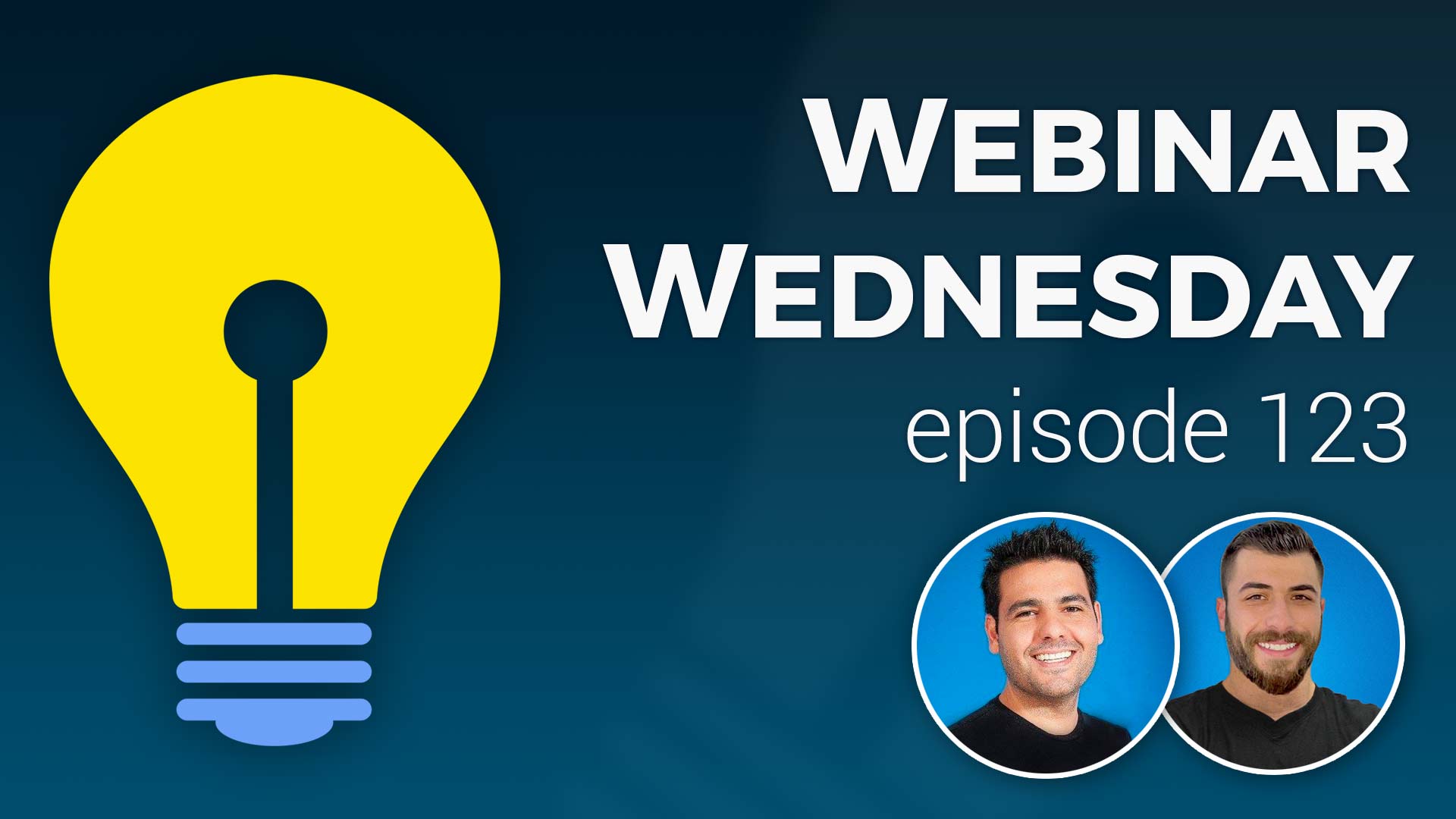
Key Topics:
- 2:39 – Update: Lazy Load Images – Phase 1: Homepage Streaming Sections
- 3:46 – Update: Support Center: Include Images/Attachments When Submitting Tickets
- 5:46 – Update: Billing Reminder Emails: Select Billing Cycles to Target
- 7:23 – Update: Speed & Security: Response Times, Caching, Queries & More
- 8:04 – Coming Soon: Zapier Integration – Phase 1: Send Contact Form Data into Zapier
- 13:48 – Coming Soon: Member Sign Ups: Customize Checkout Page & Membership Sign Up URLs
- 16:05 – Coming Soon: Google Website Translator: Make widget portable and patch-up some UI quirks.
- 16:18 – Coming Soon: Year-End Goals: Zapier Integrations, Enhanced Features for Post Comments, Newsletter Reporting, Coupon Codes for One-Off Purchases, Speeds… and Top Community Suggestions
- 17:33 – Will BD release other Zapier-like integrations?
- 18:52 – Using Zapier to send data from a third-party service into Brilliant Directories?
- 21:54 – Tip of the Week: How to Add Custom Content (and SEO Value) to Search Result Pages
- 23:02 – Default Search Result Pages
- 24:16 – What Can Be Changed/Added on Search Result Pages?
- 26:01 – Custom Elements to Include on Search Results Pages
- 27:49 – Let’s Customize a Members Search Results Page!
- 37:30 – Let’s Customize a Post Type Search Results Page!
- 43:30 – How to add custom content to a location’s post type search results page (example: events in Los Angeles)?
- 46:13 – Suggestion to create pretty URLs for Post + Location + Category
- 48:12 – Can Zapier be used to import form submissions from Jotform into a BD site?

 AI-Generated Transcript – Please excuse any inaccuracies
AI-Generated Transcript – Please excuse any inaccuracies
Update: Lazy Load Images – Phase 1: Homepage Streaming Sections (00:02:39)
- The implementation of lazy load images is expected to improve Google page speed scores and other tools by not loading images that are not visible on the screen, which can help reduce resource usage and improve page speed scores (00:02:41).
- The initial update focuses on the home page streaming sections, including blog articles, events, and members, where images will be lazy loaded to speed up load times (00:03:10).
- Future updates will Target Corporation internal pages, such as search results pages for members and posts, where images are loaded by default, to further improve page speed and lazy loading of images (00:03:28).
- The lazy loading of images is a significant step towards improving page speed, and further updates will be shared as more progress is made on this feature (00:03:01).
- The goal of this update is to improve the overall page speed and user experience by reducing the load time of images that are not immediately visible to the user (00:02:51).
Update: Support Center: Include Images/Attachments When Submitting Tickets (00:03:46)
- A new feature is now available that allows users to include attachments and images when submitting a support ticket in the admin dashboard, which was not possible prior to this update (00:03:46).
- To access this feature, users can go to their dashboard under “my account” and click on “create new ticket”, where they can choose a site, describe the issue, and attach images or files (00:04:08).
- The new ticket form also allows users to format their text using bold, Italic type, and underlined options, as well as add links to provide more context (00:04:44).
- Users can attach screenshots to their support tickets, which helps the support team to recreate the issue and provide a faster solution (00:04:57).
- Providing more information, such as direct links to the page with the issue and screenshots, helps the support team to assist users more quickly (00:05:17).
- The goal of the support team is to recreate the issue and identify the problem as quickly as possible, and users can help by providing as much information as possible when submitting a support ticket (00:05:20).
- The support team is working to provide better communication and faster assistance to users, who are often working hard on their websites and need help as quickly as possible (00:05:38).
Update: Billing Reminder Emails: Select Billing Cycles to Target (00:05:46)
- The billing reminder emails now have the option to select the billing cycles to Target Corporation when sending reminder emails to members or customers, allowing for more customization (00:05:46).
- This feature can be found under the finance section, specifically in the payment settings and additional settings, where the billing email settings are located (00:06:07).
- In the billing email settings, there is a dropdown menu that allows users to select which billing cycles should receive reminder emails, such as monthly, quarterly, semi-annually, annually, or one-time payments (00:06:22).
- This update is particularly useful for users who want to send reminder emails to annual members but not to monthly members, as they can now select the “annually” option to achieve this (00:06:33).
- To activate this feature, users simply need to select the desired billing cycles and save their changes, with a badge indicating how many cycles have been selected (00:06:49).
- The available billing cycles include monthly, quarterly, semi-annually, annually, and one-time payments, with quarterly being every three months (00:07:01).
- This update is now available, and users can make the necessary changes to their website’s billing reminder emails (00:07:12).
Update: Speed & Security: Response Times, Caching, Queries & More (00:07:23)
- The lazy load example is part of ongoing efforts to improve speed within the BD network, which includes working on improving response times, finding things that can be cached, and optimizing queries (00:07:23).
- Some of the speed updates are a result of support inquiries from users who report slow page loading, which can be due to heavy assets on a specific page, but also help identify areas for improvement in the system (00:07:39).
- The system improvements are driven by user feedback, and users are encouraged to report any issues, such as slow page loading, to help identify and fix problems (00:07:52).
- The efforts to improve speed and security are ongoing, and new updates are expected to be released soon, building on the progress made so far (00:08:00).
Coming Soon: Zapier Integration – Phase 1: Send Contact Form Data into Zapier (00:08:04)
- The first Zapier integration allows users to send contact form data into Zapier, which can then be connected to over 4,000 other solutions, and a demo of this integration is available (00:08:04).
- The integration is part of phase one, and it enables users to create different cases and Zap events to work with Zapier, starting with the low-hanging fruit of contact forms, application forms, survey forms, and newsletter forms (00:08:15).
- When a form is filled out, the data is saved in the forms inbox of the dashboard, but with Zapier, users can send this data to other platforms, such as Google Sheets, Mailchimp, Constant Contact, or HubSpot (00:09:07).
- To connect a form to Zapier, users need to edit the form settings, enable the web hook, and copy the link provided by Zapier, which is a straightforward process (00:09:50).
- A simple example of using this integration is to fill out a contact form and have it update a Google Sheet, which can be used to collect form submissions (00:10:13).
- Zapier is a critical and essential tool for businesses that work with multiple platforms, as it provides thousands of API integrations with one platform (00:11:27).
- To use Zapier, users need to create a Zapier account and set up a web hook, which involves copying a link provided by Zapier and pasting it into the form settings (00:11:51).
- The Zapier dashboard allows users to manage their zaps, and the created zap can be used to connect the form to other platforms, such as Mailchimp or Constant Contact (00:11:38).
- The form is designed to add a record to a Google Sheets, which requires connecting a Google account and specifying the actions to be taken when the form is submitted, such as creating a new spreadsheet row (00:12:04).
- A spreadsheet called “Webinar Demo Test” is created with column headings including name, email, phone, and message, and the form data is mapped to correspond to these columns (00:12:27).
- When the form is submitted, additional actions can be triggered, such as sending a thank you email to the member using Gmail or adding them to Mailchimp, allowing the website to tie into thousands of other solutions (00:12:58).
- This functionality is similar to Zapier, which can be used to connect the website to other solutions and create a better tech stack, with upcoming webinars planned to showcase use cases and help users get the most out of this feature (00:13:27).
- The goal is to help users connect better with their members and create a more integrated tech stack using solutions like Zapier, with more information and guidance to be provided in future webinars (00:13:29).
Coming Soon: Member Sign Ups: Customize Checkout Page & Membership Sign Up URLs (00:13:48)
- The ability to customize the checkout page URLs and membership sign up URLs is coming soon, allowing for more flexibility in the naming of membership plans and the URL structure (00:13:49).
- Currently, the checkout links are standardized as the website’s forward slash checkout followed by the ID of the membership plan, but this new feature will enable customization of both the word “checkout” and the membership plan ID (00:14:05).
- The new feature will allow users to change the word “checkout” to something like “register” and give the membership plan a custom name, such as “gold plan”, instead of using the plan’s ID (00:14:31).
- The settings for this feature will be located in the advanced settings, where users can search for “checkout url” or “default checkout url” to make changes, such as changing the main slug to “sign up” (00:15:11).
- Additionally, users will be able to further customize the URL based on the membership plan, allowing for a more personalized and catchy URL, such as “gold plan”, which will be available soon (00:15:46).
- The customization options will be available in two places: in the advanced settings for changing the main slug, and in the membership plan settings for changing the URL of the sign up page (00:15:01).
Coming Soon: Google Website Translator: Make widget portable and patch-up some UI quirks. (00:16:05)
- Updates are being made to the Google Translate add-on to make the widget more portable, which has encountered a few roadblocks, but is still in development (00:16:05)
- The goal of these updates is to improve the functionality and usability of the Google Translate add-on (00:16:06)
- In addition to making the widget more portable, some user interface quirks are being patched up to enhance the overall user experience (00:16:09)
Coming Soon: Year-End Goals: Zapier Integrations, Enhanced Features for Post Comments, Newsletter Reporting, Coupon Codes for One-Off Purchases, Speeds… and Top Community Suggestions (00:16:18)
- Year-end goals include more use cases for Zapier integrations, which will provide additional functionality for users (00:16:18).
- Enhancing features around post commenting is also a goal, such as the ability to upvote comments, with a potential release date at the beginning of 2022 or possibly in December (00:16:21).
- Newsletter reporting is another objective, allowing users to create smart lists of who opened or clicked on emails after sending a newsletter (00:16:40).
- The ability to have coupon codes for one-off purchases, such as leads, paper post, and digital product purchases, is also being developed (00:16:48).
- More speed updates are planned, in addition to implementing the top community suggestions from the Facebook group and support center (00:17:00).
- The community is encouraged to provide feedback and ask questions about the upcoming updates, with features like the “raise your hand” feature available for users to participate (00:17:15).
Will BD release other Zapier-like integrations? (00:17:33)
- The possibility of releasing other Zapier-like integrations, such as Connexit or web hooks, is being considered, with the goal of nailing down Zapier integrations first and then replicating its connect hooks for other platforms like Pablo (00:17:35).
- The development of integrations for other platforms will be based on their popularity, with the assumption that they work with similar models to Zapier, but may require a few different connections (00:18:08).
- The plan is to focus on perfecting Zapier integrations, which is considered the gold standard, before moving on to other solutions like Connexit or web hooks (00:18:35).
- The development team aims to offer more types of integrations beyond Zapier in the future, with the expectation that the same models and connections used for Zapier can be applied to other platforms (00:18:21).
- The team is committed to continuously updating and improving their software, with the goal of making it better over time (00:18:49).
Using Zapier to send data from a third-party service into Brilliant Directories? (00:18:52)
- The discussion involves integrating Thrive Cart with Brilliant Directories using Zapier, allowing data to be sent from one platform to another, with the goal of streamlining the checkout and sign-up process (00:18:52).
- The data to be sent from Thrive Cart to Brilliant Directories includes member registration information, which can be used to create a new member record on the Brilliant Directories site (00:19:21).
- The current focus is on sending Brilliant Directories data into Zapier, such as member reviews, lead submissions, and member signups, with the next phase being the import of events from other sources like Thrive Cart (00:20:04).
- The import of events from Thrive Cart will allow for the creation of new member records on the Brilliant Directories site, with the minimum required information being an email, password, and name (00:21:15).
- The integration with Zapier will enable the import of member data from any form or platform that has a Zapier integration, as long as it meets the minimum requirements, and this feature is expected to be available in the next phase of development (00:21:04).
- The updates and new features being developed for the Brilliant Directories platform are expected to make this one of the most exciting years for the platform, with many new workflows and integrations being set up (00:21:46).
Tip of the Week: How to Add Custom Content (and SEO Value) to Search Result Pages (00:21:54)
- The tip of the week is about adding custom content and SEO value to search result pages, a topic that was previously covered but has undergone significant changes since then (00:21:54).
- The previous coverage of this topic was approximately two and a half years ago, and it primarily focused on adding SEO value to search result pages (00:22:25).
- Since the previous coverage, several updates have been released, particularly with the web page builder, which has increased the flexibility of customizing specific search result pages (00:22:41).
- The updated customization options allow for the addition of various elements and content types to search result pages, in addition to the SEO value that can be added (00:22:50).
Default Search Result Pages (00:23:02)
- The default search result page has a basic layout that includes primary elements such as the page title or heading at the top, followed by the search results listed out, and this layout is similar for different types of search result pages, including member search result pages and post search result pages for articles, discussions, and events (00:23:02).
- The search results are listed out below the page title or heading, and the specific content of the search results will vary depending on the type of search being performed, such as a member search or a post search for articles (00:23:26).
- The search result pages may also include a sidebar, which can be edited to add custom content using widgets, and this sidebar will be applied to all search result pages of the same type unless customized individually (00:23:38).
- The sidebar on the search result pages can be customized to add specific content, but by default, the same sidebar will be used for all search result pages, regardless of the location or category being searched (00:23:48).
- Custom content can be added to specific search result pages by editing the individual pages, which allows for more tailored and relevant content to be displayed to users (00:24:10).
What Can Be Changed/Added on Search Result Pages? (00:24:16)
- On search result pages, whether it’s member search result pages or post search result pages, the same concepts apply, and the primary elements include the main title and the subtitle by default (00:24:18).
- Search result pages do not have a hero section or hero splash section at the top of the page by default, but it can be added, similar to what some websites have on their home page with a big image, search box, or call to action (00:24:30).
- Custom page content can be added to search result pages to provide additional details, context, or information, and there are different placement options for sections on the search result page where the custom page content can be placed (00:24:50).
- Editing the SEO settings and meta tags can add specific additional SEO value to the pages, and adding custom content or custom titles can also improve the SEO value of the specific page being edited (00:25:11).
- The sidebar on a search result page can be customized to include different content, such as a custom sidebar for members in a specific location, like Los Angeles, which can be different from other member search result pages (00:25:31).
- Advanced settings are available in the web page builder to further edit and customize the search result pages, providing options to add custom content in the header of the page and make other changes (00:25:53).
Custom Elements to Include on Search Results Pages (00:26:01)
- Custom content can be added to specific search result pages to provide additional SEO value, particularly for high-value or underperforming pages, and this can be achieved by utilizing the webpage builder and its various tools (00:26:02).
- The custom content can include additional context or general information to search result pages, and it is also possible to optimize the default page title with something more unique (00:26:34).
- A hero section can be added to search result pages, which contains a prominent background image above the search results, and this section can include a call to action, a bigger title, or additional information (00:26:46).
- Engagement on specific search result pages can be increased by adding additional calls to action in various places throughout the page, and these changes can be made using the webpage builder and its tools (00:27:06).
- The search result pages are dynamic, meaning that they will reflect changes such as new members joining or leaving, but the custom elements and changes made to the page will remain relevant and correct (00:27:27).
- The custom elements and changes made to the search result pages will surround the search results, providing a more personalized and engaging experience for users (00:27:39).
Let’s Customize a Members Search Results Page! (00:27:49)
- Customizing search result pages can make a website more unique and improve its general usability, with features such as automatically created profile pages for members and search result pages for categories, which can be customized to Target Corporation specific cities or categories, like Los Angeles plumbers (00:27:49).
- The site can create a large number of pages, so it’s essential to focus energy on specific areas, like popular pages or underperforming ones that need unique content to improve their Google rankings (00:28:32).
- Adding custom content to search result pages can help maintain Google rankings, especially for popular pages, and give underperforming pages an edge in search results (00:29:01).
- An example of a customized search result page is the Los Angeles business directory, which includes a hero section, updated title, subheading, and a button to add a business, making it more engaging and informative for users (00:29:25).
- The customized page also includes a “read more” tab with content about Los Angeles, which can be enhanced with links to events, coupons, and deals, as well as categories like doctors, plumbers, and lawyers, to improve the user experience and add content to the page (00:30:16).
- To create a custom page, there are two types: pages for member results and other types of pages, and the process involves using content blocks to add links, images, and text, which can be used to create a unique and engaging experience for users (00:31:07).
- To create a new webpage, go to the dashboard and click on the web page builder, then select “new web page” and paste the corresponding URL, such as “united states california Los Angeles”, and give it a nickname, such as “los angeles city page” (00:31:45).
- Under page type, select “member search results” so the system knows that the URL is corresponding to a member search results page on the site, and it will make sure that the member results still show on the page (00:32:25).
- The created page can have a hero section with a background image, title, and call to action, and additional hero section content can be added, such as widgets, shortcodes, plain text, or forms (00:34:26).
- The page can be customized with different settings, such as title font color, subtitle color, and button color, and a call to action can be added to take users to a specific page, such as a free listing for businesses (00:34:05).
- The page options also allow deciding whether to show a sidebar, which can be customized for specific pages, such as a page for Los Angeles, and can include custom content (00:35:07).
- The created page can be viewed and saved, and it will display the customized content, including the hero section and any additional content added (00:34:47).
- A custom sidebar can be created for specific search results pages, such as Los Angeles member search results, to display custom banner ads or content that correlates to the page, and this can be placed on the left, right, slim, or wide, (00:35:16).
- The placement of custom content can be flexible, allowing it to be displayed inside a tab or at the bottom of the page, below member results, to provide extra SEO content or calls to action, (00:35:48).
- Duplicating a page allows for the creation of a new page with the custom content, such as a tab with additional information, which can be useful for directing users to other areas of the site when they reach the bottom of the search results, (00:36:14).
- The custom content can include related information, such as blog posts, and internal linking can be used to direct users to other relevant articles, such as a post on top attractions in Los Angeles, (00:36:42).
- Creating custom content for multiple search results pages can be time-consuming, so it’s essential to prioritize and focus on specific cities, locations, or categories first to avoid exhaustion and overwhelm, (00:36:55).
- Custom content can include a hero section with a button, providing an example of a member search results page with custom content, and this can be a valuable way to enhance the user experience and provide additional information, (00:37:20).
Let’s Customize a Post Type Search Results Page! (00:37:30)
- A search results page was customized with a more engaging title, and the possibility of adding quick links to popular categories or keyword searches was discussed, similar to creating a tag cloud, which can be achieved with custom content on the page (00:37:40).
- To customize a post search results page, a new web page can be created, and the system will know which search results page to Target Corporation based on the selected page type, which in this case is “post search results” (00:38:30).
- The system allows for the creation of a custom page for the main search results page or for specific categories, such as “events” or “weddings”, and the process involves selecting the post type and linking it to the search results page (00:38:50).
- A custom search results page can be created for a specific category, and quick links can be added to the page to direct users to specific categories or keyword searches, such as a search for the keyword “learn” (00:40:46).
- The customization of the search results page includes the ability to add images, change font colors, and create a hero section, which can include a background image and text, and the page content section can include quick links to specific categories or keyword searches (00:40:25).
- The process of creating a custom search results page involves using the web page builder, selecting the post type, and following the steps to link the post type to the search results page, and a badge is displayed to indicate that the page was created in the web page builder (00:39:57).
- The customization options for the search results page include the ability to add a call to action, change the layout, and add buttons to direct users to specific categories or keyword searches, and the page can be customized to fit the needs of the website, such as a car site or a classified site (00:40:59).
- The discussion involves editing a section to link to “learn” and adding a button that says “start new discussion”, which links to the account dashboard for account discussions, allowing members to add discussions, events, or classifieds if they have the privilege, (00:41:27).
- A call to action is added as custom content, taking members directly to their dashboard if they are logged in, or to the login page if they are not, to encourage member sign-ups and posts, (00:42:17).
- The content section is utilized for button links, keeping it concise and avoiding multiple paragraphs, and the page options are set to display above the member search results, which can be adjusted according to preference, (00:42:41).
- The layout and design of the page are customizable, including the use of spaces to move elements, and the option to make text bold, with the goal of improving the overall user experience and encouraging engagement, (00:43:13).
- The changes made to the page are saved, and the resulting layout is reviewed, with consideration given to potential adjustments to the design and formatting, (00:43:25).
How to add custom content to a location’s post type search results page (example: events in Los Angeles)? (00:43:30)
- To add custom content to a location’s post type search results page, such as events in Los Angeles, the process involves searching for the location and copying the URL, which can then be used to create a custom page (00:43:48).
- The URL for a specific location can be obtained by searching for the location on the site, and then copying the full URL and pasting it into the URL section when editing a link (00:44:19).
- For categories plus location, a search can be done using the category and location, and then the full URL can be copied and pasted into the URL section (00:44:45).
- The post search results pages are a good place to start customizing, as they are more limited than member results pages and have fewer categories, making them lower hanging fruit to update and customize (00:45:07).
- To customize a post search results page, select the page type as “post search results” and use the chain selects to choose the corresponding post page that the customization will apply to (00:45:32).
- Adding a hero section and call to action to the post search results pages can make the site look more developed and encourage users to click and engage with the site (00:45:48).
Suggestion to create pretty URLs for Post + Location + Category (00:46:13)
- The discussion revolves around creating pretty URLs for posts, including their location and category, to allow for static pages that can be customized, such as an “LA Events” page with a hero header and a list of events in Los Angeles (00:46:27).
- Currently, it is not possible to create a static page for a post without a category, and changing the URL or link does not provide a solution to make the page look nice like a category page (00:46:48).
- The issue arises because the URL for post search results cannot be saved, and as soon as the post search results are turned on, the URL goes away, making it impossible to edit the page (00:47:08).
- The suggestion is to enable the creation of pretty URLs for posts, locations, and categories, similar to how it works for listings, to provide more flexibility and customization options (00:47:28).
- The idea is to allow users to have a static page for a particular topic, such as a “LA Events” page, which is not currently possible with the existing functionality (00:47:44).
- The suggestion has been acknowledged, and it will be discussed further to see what can be done to implement this feature (00:47:52).
- Ryan is credited with suggesting the idea of customizing the checkout page URL, which has been implemented, and is now suggesting the creation of pretty URLs for posts, locations, and categories (00:47:58).
Can Zapier be used to import form submissions from Jotform into a BD site? (00:48:12)
- The discussion revolves around using Zapier to import form submissions from Jotform into a Brilliant Directories (BD) site, with the goal of eventually having third-party solutions to zap data into the BD site, allowing it to be matched with a member as a lead or added to site data for rendering or display (00:48:14).
- A demonstration site, carrierboard.com, is used as an example, where a shipping-related form is set up using Jotform, and the goal is to submit the form data into the BD site (00:48:22).
- The site has a navigation menu with options like “Home” and “Loads”, and a “Post Load” option that submits form data, which can be connected to a table in the BD site using Zapier (00:48:38).
- The end goal is to have a system where leads gathered using Jotform can be imported into the BD site or embedded on the site, with the possibility of using third-party solutions like Zapier to automate the process (00:49:12).
- The use case is considered a perfect example of another solution where Jotform is used for lead generation and Zapier is used to import the data into the BD site (00:49:44).
- The topic is part of a larger discussion on updates and future developments, including the integration of Zapier with the BD site, which is expected to be ready for the next phase in the near future (00:50:29).
- The conversation also touches on other updates, such as adding custom content to search results pages and improving URL structures, with more updates to come (00:50:11).
- The discussion concludes with an invitation to join the Brilliant Directories Facebook group to continue the conversation and an announcement of the next webinar, where more updates and developments will be shared (00:50:40).

